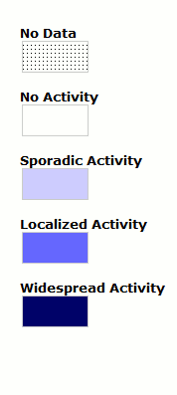FluWatch report: January 22, 2017 to January 28, 2017 (week 4)
Overall Summary
- Influenza activity continues to be reported across Canada and a few regions are reporting widespread influenza activity.
- All indicators (laboratory detections, influenza-like illness, outbreaks and hospitalizations) have either decreased or remained similar to the previous week.
- In week 04, 51 outbreaks were reported, the majority in long-term care facilities and due to influenza A.
- A(H3N2) continues to be the most common type of influenza affecting Canadians.
- The majority of laboratory detections, hospitalizations and deaths have been among adults aged 65+ years.
- For more information on the flu, see our Flu(influenza) web page.
On this page
- Influenza/ILI Activity (geographic spread)
- Laboratory Confirmed Influenza Detections
- Syndromic/Influenza-like Illness Surveillance
- Influenza Outbreak Surveillance
- Provincial/Territorial Influenza Hospitalizations and Deaths
- Sentinel Hospital Influenza Surveillance
- Influenza Strain Characterizations
- Antiviral Resistance
- Provincial and International Influenza Reports
- FluWatch definitions for the 2016-2017 season

Download the alternative format
(PDF format, 805KB, 9 pages)
Date published: 2017-02-03
Related Topics
Influenza/Influenza-like Illness Activity (geographic spread)
In week 04, all but four regions (two in NL, and one each in NB and MB) are reporting influenza or influenza-like illness activity. Sporadic influenza activity was reported in 24 regions across thirteen provinces and territories. Localized activity was reported in 21 regions across six provinces. Widespread activity was reported in two provinces (two regions each in BC and AB). For more details on a specific region, click on the map.
Figure 1 – Map of overall influenza/ILI activity level by province and territory, Canada, week 4
Note: Influenza/ILI activity levels, as represented on this map, are assigned and reported by Provincial and Territorial Ministries of Health, based on laboratory confirmations, sentinel ILI rates and reported outbreaks. Please refer to detailed definitions at the end of the report. Maps from previous weeks, including any retrospective updates, are available in the mapping feature found in the Weekly Influenza Reports.
Figure 1 - Text Description
In week 04, all but four regions (two in NL, and one each in NB and MB) are reporting influenza or influenza-like illness activity. Sporadic influenza activity was reported in 24 regions across thirteen provinces and territories. Localized activity was reported in 21 regions across six provinces. Widespread activity was reported in two provinces (two regions each in AB and BC).
Laboratory Confirmed Influenza Detections
In week 04, the percentage of tests positive for influenza remained similar to the previous week at 23%. For data on other respiratory virus detections, see the Respiratory Virus Detections in Canada Report on the Public Health Agency of Canada (PHAC) website.
Figure 2 – Number of positive influenza tests and percentage of tests positive, by type, subtype and report week, Canada, 2016-17, week 4
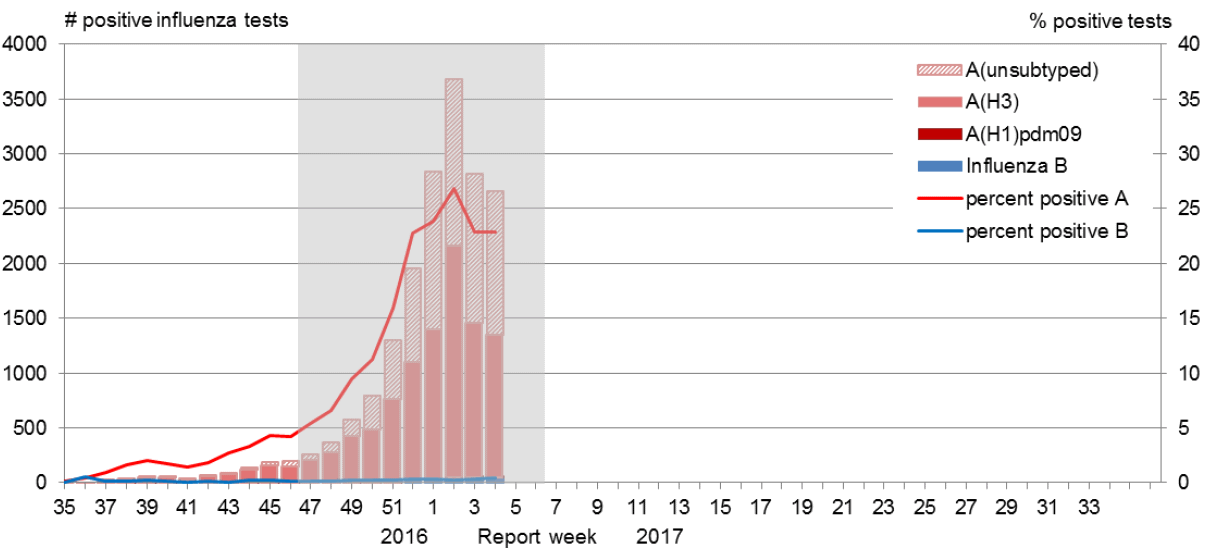
The shaded area indicates weeks where the positivity rate was at least 5% and a minimum of 15 positive tests were observed, signalling the start and end of seasonal influenza activity.
Figure 2 - Text Description
| Report Week | A(Unsubtyped) | A(H3) | A(H1)pdm09 | Influenza B |
|---|---|---|---|---|
| 35 | 0 | <5 | 0 | 0 |
| 36 | <5 | 0 | <5 | 9 |
| 37 | <5 | 17 | 0 | <5 |
| 38 | 11 | 28 | <5 | <5 |
| 39 | 14 | 41 | <5 | 7 |
| 40 | 0 | 47 | <5 | <5 |
| 41 | 10 | 31 | 0 | <5 |
| 42 | 14 | 49 | <5 | 6 |
| 43 | 16 | 76 | <5 | <5 |
| 44 | 19 | 110 | <5 | 9 |
| 45 | 31 | 150 | <5 | 11 |
| 46 | 52 | 140 | <5 | 7 |
| 47 | 54 | 200 | 0 | 9 |
| 48 | 91 | 272 | <5 | 7 |
| 49 | 148 | 414 | <5 | 12 |
| 50 | 305 | 467 | <5 | 18 |
| 51 | 535 | 750 | <5 | 17 |
| 52 | 857 | 1064 | <5 | 33 |
| 1 | 1444 | 1360 | <5 | 38 |
| 2 | 1516 | 2118 | 10 | 39 |
| 3 | 1354 | 1412 | 0 | 47 |
| 4 | 1313 | 1299 | <5 | 48 |
| 5 | 0 | 0 | 0 | 0 |
| 6 | 0 | 0 | 0 | 0 |
| 7 | 0 | 0 | 0 | 0 |
| 8 | 0 | 0 | 0 | 0 |
| 9 | 0 | 0 | 0 | 0 |
| 10 | 0 | 0 | 0 | 0 |
| 11 | 0 | 0 | 0 | 0 |
| 12 | 0 | 0 | 0 | 0 |
| 13 | 0 | 0 | 0 | 0 |
| 14 | 0 | 0 | 0 | 0 |
| 15 | 0 | 0 | 0 | 0 |
| 16 | 0 | 0 | 0 | 0 |
| 17 | 0 | 0 | 0 | 0 |
| 18 | 0 | 0 | 0 | 0 |
| 19 | 0 | 0 | 0 | 0 |
| 20 | 0 | 0 | 0 | 0 |
| 21 | 0 | 0 | 0 | 0 |
| 22 | 0 | 0 | 0 | 0 |
| 23 | 0 | 0 | 0 | 0 |
| 24 | 0 | 0 | 0 | 0 |
| 25 | 0 | 0 | 0 | 0 |
| 26 | 0 | 0 | 0 | 0 |
| 27 | 0 | 0 | 0 | 0 |
| 28 | 0 | 0 | 0 | 0 |
| 29 | 0 | 0 | 0 | 0 |
| 30 | 0 | 0 | 0 | 0 |
| 31 | 0 | 0 | 0 | 0 |
| 32 | 0 | 0 | 0 | 0 |
| 33 | 0 | 0 | 0 | 0 |
| 34 | 0 | 0 | 0 | 0 |
Nationally in week 04, 2,586 positive influenza tests were reported, down from 2,667 tests reported in week 03. Many provinces and territories reported decreased influenza detections in week 04 but some regions such as the Atlantic region reported increased influenza detections from the previous week. To date, 17,914 laboratory confirmed influenza detections have been reported, of which 98% have been influenza A. Influenza A(H3N2) is the most common subtype detected, representing over 99% of subtyped influenza A detections (10038/10080). For more detailed weekly and cumulative influenza data, see the text descriptions for Figures 2 and 3 or the Respiratory Virus Detections in Canada Report.
Figure 3 – Cumulative numbers of positive influenza specimens by type/subtype and province/territory, Canada, 2016-17, week 4

Figure 3 - Text Description
| Reporting provincesTable Figure 3 - Footnote 1 |
Weekly (January 22, 2017 to January 28, 2017) | Cumulative (August 28, 2016 to January 28, 2016) | |||||||||
|---|---|---|---|---|---|---|---|---|---|---|---|
| Influenza A | B | Influenza A | B | A & B Total |
|||||||
| A Total |
A (H1)pdm09 |
A (H3) |
ATable Figure 3 - Footnote UnS | B Total |
A Total |
A (H1)pdm09 |
A (H3) |
ATable Figure 3 - Footnote UnS | B Total |
||
| BC | 529 | 0 | 183 | 346 | 17 | 2583 | 3 | 1118 | 1462 | 72 | 2655 |
| AB | 212 | 0 | 204 | 8 | 14 | 2975 | 8 | 2896 | 71 | 54 | 3029 |
| SK | 77 | 0 | 50 | 27 | 1 | 1085 | 0 | 554 | 531 | 13 | 1098 |
| MB | 43 | 0 | 1 | 42 | 0 | 100 | 0 | 49 | 51 | 10 | 110 |
| ON | 853 | 2 | 700 | 151 | 6 | 5901 | 28 | 4768 | 1105 | 64 | 5965 |
| QC | 669 | 0 | 55 | 614 | 8 | 4246 | 0 | 291 | 3954 | 106 | 4352 |
| NB | 65 | 0 | 10 | 55 | 0 | 180 | 1 | 28 | 151 | 3 | 183 |
| NS | 34 | 0 | 0 | 34 | 0 | 125 | 0 | 13 | 112 | 0 | 125 |
| PE | 20 | 0 | 20 | 0 | 1 | 73 | 1 | 72 | 0 | 1 | 74 |
| NL | 10 | 0 | 0 | 10 | 1 | 53 | 0 | 33 | 20 | 5 | 58 |
| YT | 2 | 0 | 0 | 2 | 0 | 189 | 0 | 142 | 47 | 1 | 190 |
| NT | 5 | 0 | 5 | 0 | 0 | 27 | 0 | 27 | 0 | 0 | 27 |
| NU | 19 | 0 | 19 | 0 | 0 | 47 | 0 | 47 | 0 | 1 | 48 |
| Canada | 2538 | 2 | 1247 | 1289 | 48 | 17584 | 41 | 10038 | 7504 | 330 | 17914 |
| PercentageTable Figure 3 - Footnote 2 | 98% | 0% | 49% | 51% | 2% | 98% | 0% | 57% | 43% | 2% | 100% |
To date, detailed information on age and type/subtype has been received for 12,694 laboratory confirmed influenza cases. Among cases with reported age and type/subtype information, adults aged 65+ accounted for almost half of the reported influenza cases and the largest proportion (45%) of influenza A (H3N2) cases.
| Age groups (years) | Weekly (January 22 to January 28, 2017) | Cumulative (August 28, 2016 to January 28, 2017) | ||||||||||
|---|---|---|---|---|---|---|---|---|---|---|---|---|
| Influenza A | B | Influenza A | B | Influenza A and B | ||||||||
| A Total | A(H1) pdm09 | A(H3) | ATable 1 - Footnote UnS | Total | A Total | A(H1) pdm09 | A(H3) | ATable 1 - Footnote UnS | Total | # | % | |
| <5 | 140 | 0 | 41 | 99 | <5 | >1010 | <5 | 465 | 545 | 47 | >1057 | x% |
| 5-19 | 147 | 0 | 54 | 93 | 5 | >1235 | <5 | 682 | 553 | 41 | >1276 | x% |
| 20-44 | 185 | 0 | 67 | 118 | <5 | 1944 | 6 | 1079 | 859 | 38 | 1982 | 16% |
| 45-64 | 191 | 0 | 69 | 122 | 7 | 2131 | 10 | 1100 | 1021 | 48 | 2179 | 17% |
| 65+ | 604 | 0 | 172 | 432 | 13 | >6119 | <5 | 2775 | 3344 | 74 | >6193 | x% |
| Total | 1267 | 0 | 403 | 864 | 29 | 12446 | 23 | 6101 | 6322 | 248 | 12694 | 100% |
| PercentageTable 1 - Footnote 2 | 98% | 0% | 32% | 68% | 2% | 98% | 0% | 49% | 51% | 2% | ||
Syndromic/Influenza-like Illness Surveillance
Healthcare Professionals Sentinel Syndromic Surveillance
In week 04, 2.0% of visits to healthcare professionals were due to influenza-like illness.
Figure 4 - Percentage of visits for ILI reported by sentinels by report week, Canada, 2016-17, week 4
Number of Sentinels Reporting Week 04: 108
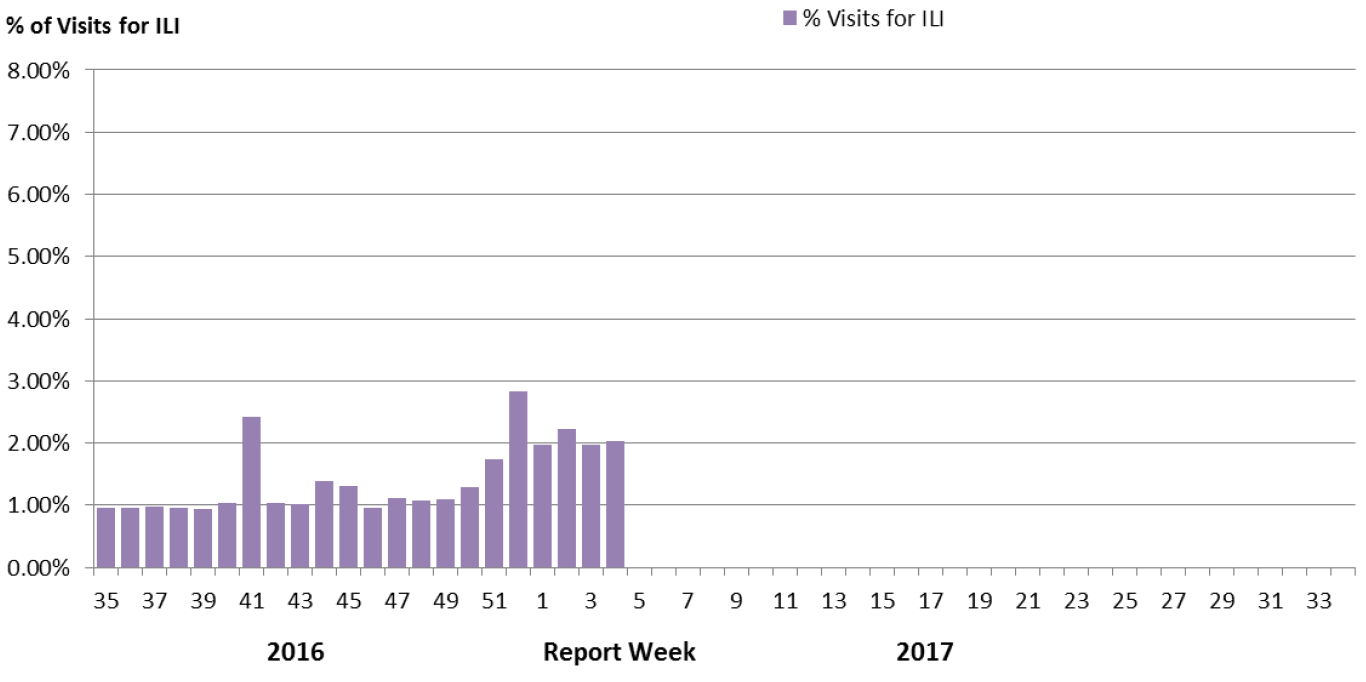
Delays in the reporting of data may cause data to change retrospectively. In BC, AB, and SK, data are compiled by a provincial sentinel surveillance program for reporting to FluWatch. Not all sentinel physicians report every week.
Figure 4 - Text Description
| Report week | % Visits for ILI |
|---|---|
| 35 | 0.96% |
| 36 | 0.96% |
| 37 | 0.98% |
| 38 | 0.96% |
| 39 | 0.94% |
| 40 | 1.03% |
| 41 | 2.41% |
| 42 | 1.04% |
| 43 | 1.01% |
| 44 | 1.39% |
| 45 | 1.32% |
| 46 | 0.97% |
| 47 | 1.11% |
| 48 | 1.07% |
| 49 | 1.08% |
| 50 | 1.30% |
| 51 | 1.73% |
| 52 | 2.83% |
| 1 | 1.96% |
| 2 | 2.22% |
| 3 | 1.96% |
| 4 | 2.04% |
| 5 | |
| 6 | |
| 7 | |
| 8 | |
| 9 | |
| 10 | |
| 11 | |
| 12 | |
| 13 | |
| 14 | |
| 15 | |
| 16 | |
| 17 | |
| 18 | |
| 19 | |
| 20 | |
| 21 | |
| 22 | |
| 23 | |
| 24 | |
| 25 | |
| 26 | |
| 27 | |
| 28 | |
| 29 | |
| 30 | |
| 31 | |
| 32 | |
| 33 | |
| 34 |
Are you a primary healthcare practitioner (General Practitioner, Nurse Practitioner or Registered Nurse) interested in becoming a FluWatch sentinel?
Please visit our Influenza Sentinel page for more details.
Influenza Outbreak Surveillance
In week 04, 51 laboratory confirmed influenza outbreaks were reported: 35 in long-term care (LTC) facilities, eight in hospitals and eight in institutional or community (other) settings. All outbreaks were due to influenza A. Of the outbreaks with known strains or subtypes, seven were due to influenza A(H3N2) and 23 were due to influenza A(UnS). An additional three outbreaks due to ILI were reported in schools.
To date this season, 598 outbreaks have been reported and the majority (68%) have occurred in LTC facilities. Compared to the same period in the 2014-15 season, the previous influenza A(H3N2)-predominant season, 1,146 outbreaks were reported, of which 75% occurred in LTC facilities.
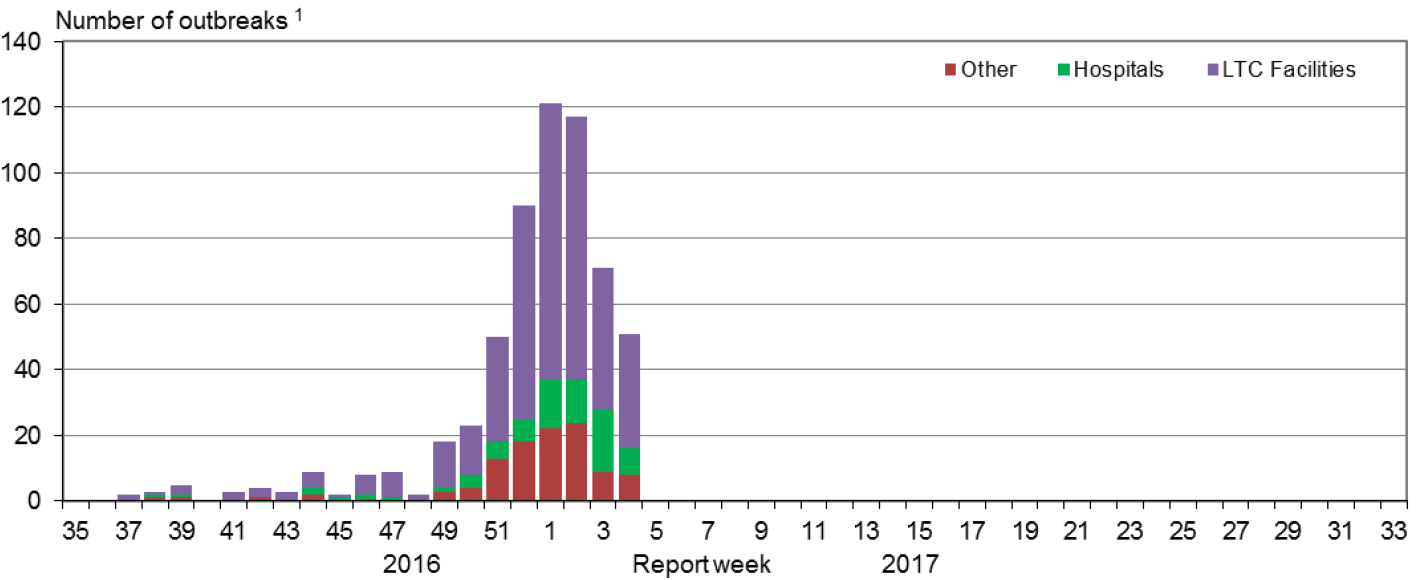
Figure 5 - Text Description
| Report week | Hospitals | Long Term Care Facilities | Other |
|---|---|---|---|
| 35 | 0 | 0 | 0 |
| 36 | 0 | 0 | 0 |
| 37 | 0 | 2 | 0 |
| 38 | 1 | 1 | 1 |
| 39 | 1 | 3 | 1 |
| 40 | 0 | 0 | 0 |
| 41 | 0 | 3 | 0 |
| 42 | 0 | 3 | 1 |
| 43 | 0 | 3 | 0 |
| 44 | 2 | 5 | 2 |
| 45 | 1 | 1 | 0 |
| 46 | 2 | 6 | 0 |
| 47 | 1 | 8 | 0 |
| 48 | 0 | 2 | 0 |
| 49 | 1 | 14 | 3 |
| 50 | 4 | 15 | 4 |
| 51 | 5 | 32 | 13 |
| 52 | 7 | 65 | 18 |
| 1 | 15 | 84 | 22 |
| 2 | 13 | 80 | 24 |
| 3 | 19 | 43 | 9 |
| 4 | 8 | 35 | 8 |
| 5 | 0 | 0 | 0 |
| 6 | 0 | 0 | 0 |
| 7 | 0 | 0 | 0 |
| 8 | 0 | 0 | 0 |
| 9 | 0 | 0 | 0 |
| 10 | 0 | 0 | 0 |
| 11 | 0 | 0 | 0 |
| 12 | 0 | 0 | 0 |
| 13 | 0 | 0 | 0 |
| 14 | 0 | 0 | 0 |
| 15 | 0 | 0 | 0 |
| 16 | 0 | 0 | 0 |
| 17 | 0 | 0 | 0 |
| 18 | 0 | 0 | 0 |
| 19 | 0 | 0 | 0 |
| 20 | 0 | 0 | 0 |
| 21 | 0 | 0 | 0 |
| 22 | 0 | 0 | 0 |
| 23 | 0 | 0 | 0 |
| 24 | 0 | 0 | 0 |
| 25 | 0 | 0 | 0 |
| 26 | 0 | 0 | 0 |
| 27 | 0 | 0 | 0 |
| 28 | 0 | 0 | 0 |
| 29 | 0 | 0 | 0 |
| 30 | 0 | 0 | 0 |
| 31 | 0 | 0 | 0 |
| 32 | 0 | 0 | 0 |
| 33 | 0 | 0 | 0 |
| 34 | 0 | 0 | 0 |
Provincial/Territorial Influenza Hospitalizations and Deaths
In week 04, 423 influenza-associated hospitalizations were reported by participating provinces and territories*. Influenza A accounted for the majority of hospitalizations (97%). Adults aged 65+ accounted for the largest proportion of hospitalizations (69%). A total of six intensive care unit (ICU) admissions and 24 deaths were reported in week 04.
To date this season, 2,964 hospitalizations have been reported, of which 99% were due to influenza A. Among cases for which the subtype of influenza A was reported, almost all (1692/1698) were influenza A(H3N2). Adults 65+ accounted for 70% of the hospitalizations. One hundred and one ICU admissions and greater than 105 deaths have been reported. The majority of deaths were reported in adults aged 65+ years.
| Age Groups (years) | Cumulative (August 28, 2016 to Jan. 28 2017) | ||||||
|---|---|---|---|---|---|---|---|
| Hospitalizations | ICU Admissions | Deaths | |||||
| Influenza A Total | Influenza B Total | Total [# (%)] | Influenza A and B Total | % | Influenza A and B Total | % | |
| 0-4 | 200 | 7 | 207 (7%) | 7 | 7% | 0 | x% |
| 5-19 | 122 | 7 | 129 (4%) | 8 | 8% | <5 | x% |
| 20-44 | 164 | <5 | >164 (x%) | 8 | 8% | 0 | x% |
| 45-64 | 391 | <5 | >391 (x%) | 29 | 29% | 16 | x% |
| 65+ | 2042 | 25 | 2067 (70%) | 49 | 48% | 89 | x% |
| Total | 2919 | 45 | 2964 (100%) | 101 | 100% | >105 | 100% |
Note: Influenza-associated hospitalizations are not reported to PHAC by: BC, NU, and QC. Only hospitalizations that require intensive medical care are reported by SK. ICU admissions x Supressed to prevent residual disclosure |
|||||||
Sentinel Hospital Influenza Surveillance
Pediatric Influenza Hospitalizations and Deaths
In week 04, 31 laboratory-confirmed influenza-associated pediatric (≤16 years of age) hospitalizations were reported by the Immunization Monitoring Program Active (IMPACT) network. All cases were due to influenza A. The number of hospitalizations reported in week 04 is below the six year average for the same time period (Figure 7).
To date this season, 270 laboratory-confirmed influenza-associated pediatric hospitalizations were reported by the IMPACT network. Children aged 0-23 months accounted for approximately 40% of hospitalizations. Influenza A accounted for 94% (n=253) of the reported hospitalizations, of which 45% (n=113) were influenza A(H3N2) and the remainder were A(UnS). Additionally, 45 intensive care unit (ICU) admissions have been reported, of which the largest proportion (29%) was reported in children 0-23 months. A total of 28 ICU cases reported at least one underlying condition or comorbidity. No deaths have been reported this season.
In 2014-15, the previous influenza A(H3N2)-predominant season, there were 467 hospitalizations, 53 ICU admissions and less than five deaths reported as of week 04.
Figure 6 - Cumulative numbers of pediatric hospitalizations (≤16 years of age) with influenza by type and age-group reported by the IMPACT network, Canada, 2016-17, week 4
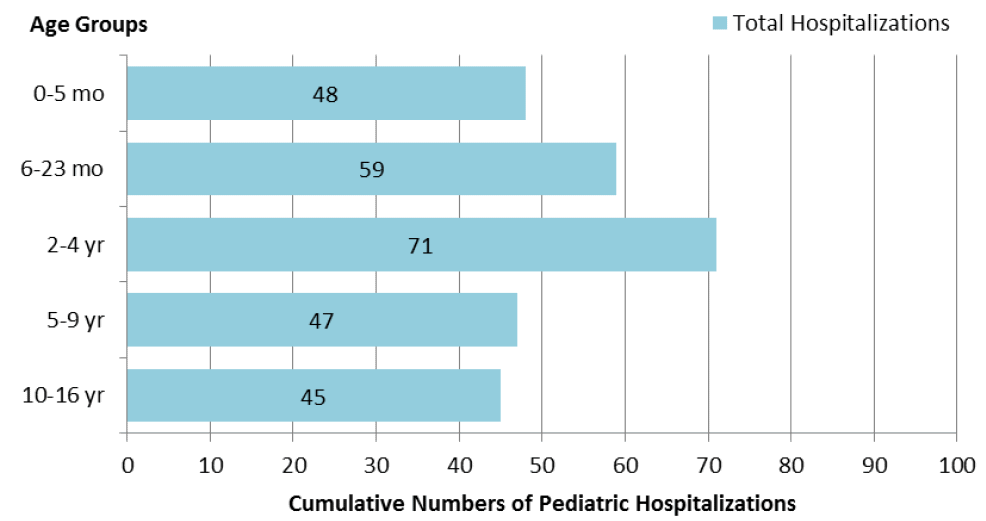
Figure 6 - Text Description
| Age Group | Total |
|---|---|
| 0-5 mo | 47 |
| 6-23 mo | 59 |
| 2-4 yr | 71 |
| 5-9 yr | 47 |
| 10-16 yr | 45 |
Figure 7 – Number of pediatric hospitalizations (≤16 years of age) with influenza reported by the IMPACT network, by week, Canada, 2016-17, week 4
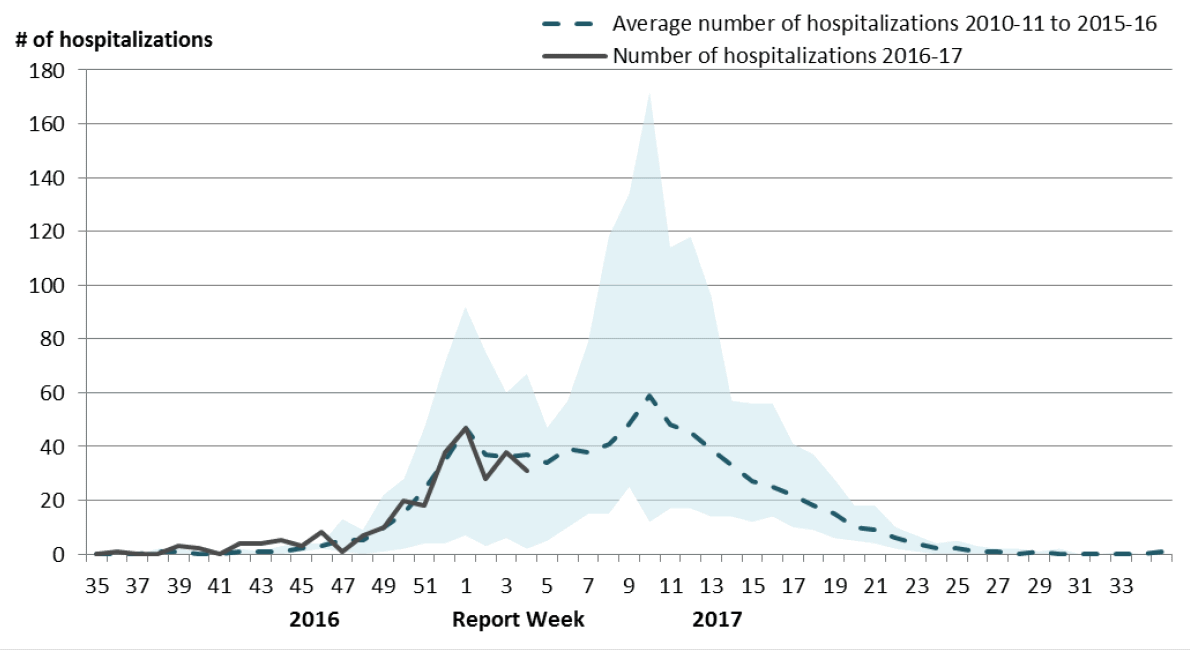
The shaded area represents the maximum and minimum number of cases reported by week from seasons 2010-11 to 2015-16.
The number of hospitalizations reported through IMPACT represents a subset of all influenza-associated pediatric and adult hospitalizations in Canada. Delays in the reporting of data may cause data to change retrospectively.
Figure 7 - Text Description
| Report week | 2016-17 | Average | Min | Max |
|---|---|---|---|---|
| 35 | 0 | 0 | 0 | 0 |
| 36 | 1 | 0 | 0 | 0 |
| 37 | 0 | 1 | 0 | 2 |
| 38 | 0 | 1 | 0 | 2 |
| 39 | 3 | 0 | 0 | 1 |
| 40 | 2 | 0 | 0 | 1 |
| 41 | 0 | 1 | 0 | 2 |
| 42 | 4 | 1 | 0 | 1 |
| 43 | 4 | 1 | 0 | 3 |
| 44 | 5 | 2 | 1 | 4 |
| 45 | 3 | 3 | 2 | 4 |
| 46 | 8 | 5 | 1 | 13 |
| 47 | 1 | 5 | 0 | 9 |
| 48 | 7 | 10 | 1 | 22 |
| 49 | 10 | 15 | 2 | 28 |
| 50 | 20 | 24 | 4 | 47 |
| 51 | 18 | 35 | 4 | 71 |
| 52 | 38 | 47 | 7 | 92 |
| 1 | 47 | 37 | 3 | 75 |
| 2 | 28 | 36 | 6 | 60 |
| 3 | 38 | 37 | 2 | 67 |
| 4 | 31 | 34 | 5 | 47 |
| 5 | #N/A | 39 | 10 | 57 |
| 6 | #N/A | 38 | 15 | 79 |
| 7 | #N/A | 41 | 15 | 118 |
| 8 | #N/A | 48 | 25 | 134 |
| 9 | #N/A | 59 | 12 | 172 |
| 10 | #N/A | 48 | 17 | 114 |
| 11 | #N/A | 45 | 17 | 118 |
| 12 | #N/A | 39 | 14 | 96 |
| 13 | #N/A | 33 | 14 | 57 |
| 14 | #N/A | 27 | 12 | 56 |
| 15 | #N/A | 25 | 14 | 56 |
| 16 | #N/A | 22 | 10 | 41 |
| 17 | #N/A | 18 | 9 | 37 |
| 18 | #N/A | 15 | 6 | 28 |
| 19 | #N/A | 10 | 5 | 18 |
| 20 | #N/A | 9 | 4 | 18 |
| 21 | #N/A | 6 | 2 | 10 |
| 22 | #N/A | 4 | 1 | 7 |
| 23 | #N/A | 2 | 0 | 4 |
| 24 | #N/A | 2 | 0 | 5 |
| 25 | #N/A | 1 | 0 | 3 |
| 26 | #N/A | 1 | 0 | 2 |
| 27 | #N/A | 0 | 0 | 2 |
| 28 | #N/A | 1 | 0 | 1 |
| 29 | #N/A | 0 | 0 | 2 |
| 30 | #N/A | 0 | 0 | 0 |
| 31 | #N/A | 0 | 0 | 0 |
| 32 | #N/A | 0 | 0 | 1 |
| 33 | #N/A | 0 | 0 | 0 |
| 34 | #N/A | 1 | 0 | 2 |
Adult Influenza Hospitalizations and Deaths
In week 04, 84 laboratory-confirmed influenza-associated adult (≥20 years of age) hospitalizations were reported by the Canadian Immunization Research Network (CIRN). All but one case were due to influenza A and the majority of cases (81%) occurred in adults aged 65+.
To date this season, 619 laboratory-confirmed influenza-associated adult (≥20 years of age) hospitalizations have been reported by CIRN. All but six hospitalized cases were due to influenza A. Adults aged 65+ accounted for 77% of hospitalizations. To date, greater than 30 intensive care unit (ICU) admissions have been reported. A total of 20 ICU cases reported at least one underlying condition or comorbidity. The median age of patients admitted to the ICU was 69 years. A total of 12 deaths have been reported this season, all in adults aged 65+. The median age of reported deaths was 82 years.
Figure 8 - Cumulative numbers of adult hospitalizations (≥20 years of age) with influenza by type and age-group reported by CIRN, Canada, 2016-17, week 4
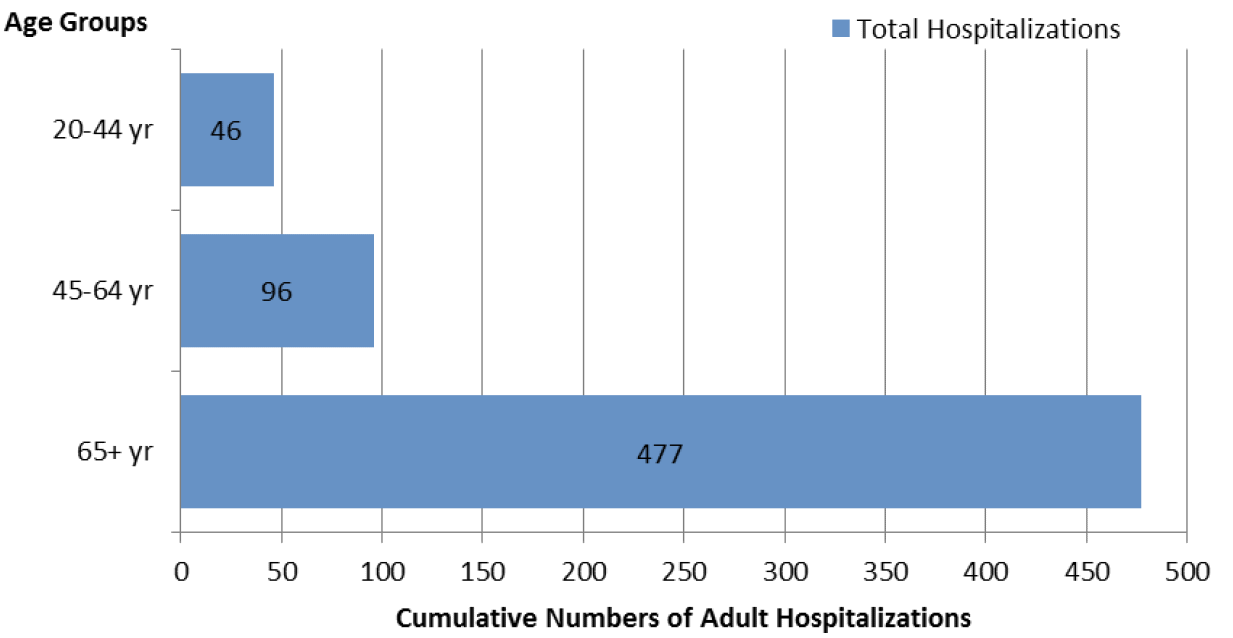
Figure 8 - Text Description
| Age Group | Total |
|---|---|
| 20-44 yr | 46 |
| 45-64 yr | 96 |
| 65+ yr | 477 |
Figure 9 – Percentage of hospitalizations, ICU admissions and deaths with influenza by age-group (≥20 years of age) reported by CIRN, Canada 2016-17, week 4

The number of hospitalizations reported through CIRN represents a subset of all influenza-associated adult hospitalizations in Canada. Delays in the reporting of data may cause data to change retrospectively.
Figure 9 - Text Description
| Age-group (years) | Hospitalizations (n= >619) | ICU admissions (n= <30) | Deaths (n= <18) |
|---|---|---|---|
| 20-44 | 7.4% | 3.0% | - |
| 45-64 | 15.5% | 19.4% | - |
| 65+ | 77.1% | 77.4% | 100.0% |
- Supressed due to small values |
|||
Influenza Strain Characterizations
During the 2016-17 influenza season, the National Microbiology Laboratory (NML) has characterized 459 influenza viruses [417 A(H3N2), 10 A(H1N1), 32 influenza B]. All but one influenza A virus (n=426) and all (n=32) influenza B viruses characterized were antigentically or genetically similar to the vaccine strains included in both the trivalent and quadrivalent vaccines. Seventeen influenza B viruses were similar to the strain which is included only in the quadrivalent vaccine.
| Strain Characterization ResultsTable 3 - Footnote 1 | Count | Description |
|---|---|---|
| Influenza A (H3N2) | ||
| Antigenically A/Hong Kong/4801/2014-like |
147 | Viruses antigenically similar to A/Hong Kong/4801/2014, the A(H3N2) component of the 2016-17 Northern Hemisphere's trivalent and quadrivalent vaccine. |
| GeneticallyTable 3 - Footnote 2 A/Hong Kong/4801/2014-like |
269 | Viruses belonging to genetic group 3C.2a. A/Hong Kong/4801/2014-like virus belongs to genetic group 3C.2a and is the influenza A(H3N2) component of the 2016-17 Northern Hemisphere's trivalent and quadrivalent vaccine. Additionally, genetic characterization of the 147 influenza A (H3N2) viruses that underwent HI testing determined that 112 viruses belonged to genetic group 3C.2a and 25 viruses belonged to genetic group 3C.3a. Sequencing is pending for the remaining 10 isolates. The majority of viruses belonging to genetic group 3C.3a are inhibited by antisera raised against A/Hong Kong/4801/2014Table 3 - Footnote 3. |
| Antigenically A/Indiana/10/2011-likeTable 3 - Footnote 4 |
1 | Viruses antigenically similar to A/Indiana/10/2011, a candidate H3N2v vaccine virus. |
| Influenza A (H1N1) | ||
| A/California/7/2009-like | 10 | Viruses antigenically similar to A/California/7/2009, the A(H1N1) component of the 2016-17 Northern Hemisphere's trivalent and quadrivalent vaccine influenza vaccine. |
| Influenza B | ||
| B/Brisbane/60/2008-like (Victoria lineage) |
15 | Viruses antigenically similar to B/Brisbane/60/2008, the influenza B component of the 2016-17 Northern Hemisphere's trivalent and quadrivalent influenza vaccine |
| B/Phuket/3073/2013-like (Yamagata lineage) |
17 | Viruses antigenically similar to B/Phuket/3073/2013, the additional influenza B component of the 2016-17 Northern Hemisphere quadrivalent influenza vaccine. |
Antiviral Resistance
During the 2016-17 season, the National Microbiology Laboratory (NML) has tested 345 influenza viruses for resistance to oseltamivir, 344 to zanamivir and 132 to amantadine. All viruses were sensitive to oseltamivir and zanamivir. All 132 influenza A viruses were resistant to amantadine (Table 4).
| Virus type and subtype | Oseltamivir | Zanamivir | Amantadine | |||
|---|---|---|---|---|---|---|
| # tested | # resistant (%) | # tested | # resistant (%) | # tested | # resistant (%) | |
| A (H3N2) | 303 | 0 (0%) | 303 | 0 (0%) | 123 | 123 (100%) |
| A (H3N2v) | 1 | 0 (0%) | 1 | 0 (0%) | 1 | 1 (100%) |
| A (H1N1) | 10 | 0 (0%) | 9 | 0 (0%) | 8 | 8 (100%) |
| B | 31 | 0 (0%) | 31 | 0 (0%) | N/ATable 4 - Footnote * | N/ATable 4 - Footnote * |
| TOTAL | 345 | 0 (0%) | 344 | 0 (0%) | 132 | 132 (100%) |
Provincial and International Influenza Reports
- World Health Organization influenza update
- World Health Organization FluNet
- WHO Influenza at the human-animal interface
- Centers for Disease Control and Prevention seasonal influenza report
- European Centre for Disease Prevention and Control - epidemiological data
- South Africa Influenza surveillance report
- New Zealand Public Health Surveillance
- Australia Influenza Report
- Pan-American Health Organization Influenza Situation Report
- Alberta Health - Influenza Surveillance Report
- BC - Centre for Disease Control (BCCDC) - Influenza Surveillance
- New Brunswick - Influenza Surveillance Reports
- Newfoundland and Labrador - Surveillance and Disease Reports
- Nova Scotia - Flu Information
- Public Health Ontario - Ontario Respiratory Pathogen Bulletin
- Quebec - Système de surveillance de la grippe
- Manitoba - Epidemiology and Surveillance - Influenza Reports
- Saskatchewan - influenza Reports
- PEI - Influenza Summary
FluWatch definitions for the 2016-2017 season
Abbreviations: Newfoundland/Labrador (NL), Prince Edward Island (PE), New Brunswick (NB), Nova Scotia (NS), Quebec (QC), Ontario (ON), Manitoba (MB), Saskatchewan (SK), Alberta (AB), British Columbia (BC), Yukon (YT), Northwest Territories (NT), Nunavut (NU).
Influenza-like-illness (ILI): Acute onset of respiratory illness with fever and cough and with one or more of the following - sore throat, arthralgia, myalgia, or prostration which is likely due to influenza. In children under 5, gastrointestinal symptoms may also be present. In patients under 5 or 65 and older, fever may not be prominent.
ILI/Influenza outbreaks
- Schools:
- Greater than 10% absenteeism (or absenteeism that is higher (e.g. >5-10%) than expected level as determined by school or public health authority) which is likely due to ILI.
Note: it is recommended that ILI school outbreaks be laboratory confirmed at the beginning of influenza season as it may be the first indication of community transmission in an area. - Hospitals and residential institutions:
- two or more cases of ILI within a seven-day period, including at least one laboratory confirmed case. Institutional outbreaks should be reported within 24 hours of identification. Residential institutions include but not limited to long-term care facilities (LTCF) and prisons.
- Workplace:
- Greater than 10% absenteeism on any day which is most likely due to ILI.
- Other settings:
- two or more cases of ILI within a seven-day period, including at least one laboratory confirmed case; i.e. closed communities.
Note that reporting of outbreaks of influenza/ILI from different types of facilities differs between jurisdictions.
Influenza/ILI activity level
1 = No activity: no laboratory-confirmed influenza detections in the reporting week, however, sporadically occurring ILI may be reported
2 = Sporadic: sporadically occurring ILI and lab confirmed influenza detection(s) with no outbreaks detected within the influenza surveillance region Footnote †
3 = Localized:
- evidence of increased ILIFootnote * and
- lab confirmed influenza detection(s) together with
- outbreaks in schools, hospitals, residential institutions and/or other types of facilities occurring in less than 50% of the influenza surveillance regionFootnote †
4 = Widespread:
- evidence of increased ILIFootnote * and
- lab confirmed influenza detection(s) together with
- outbreaks in schools, hospitals, residential institutions and/or other types of facilities occurring in greater than or equal to 50% of the influenza surveillance regionFootnote †
Note: ILI data may be reported through sentinel physicians, emergency room visits or health line telephone calls.

